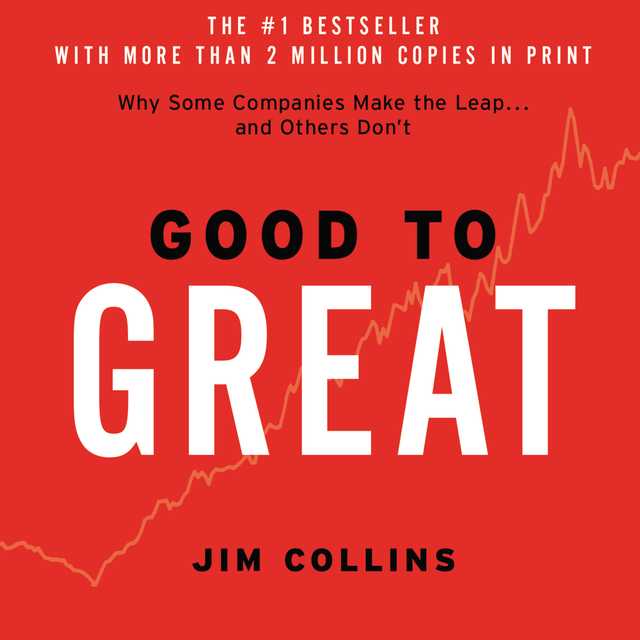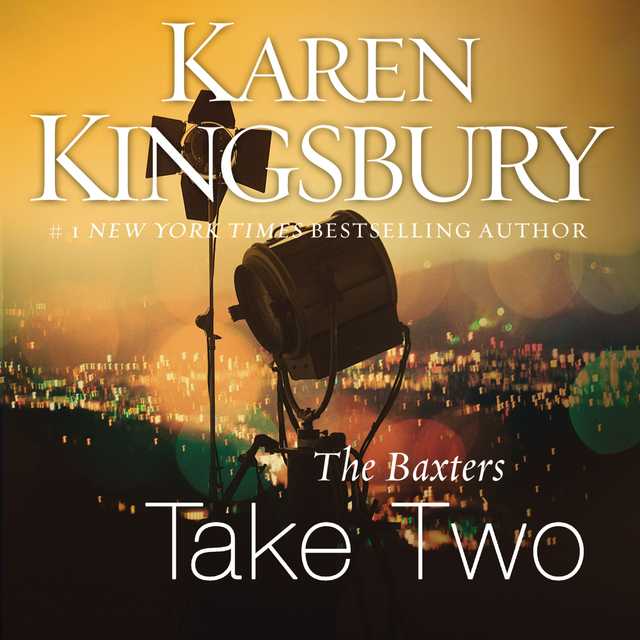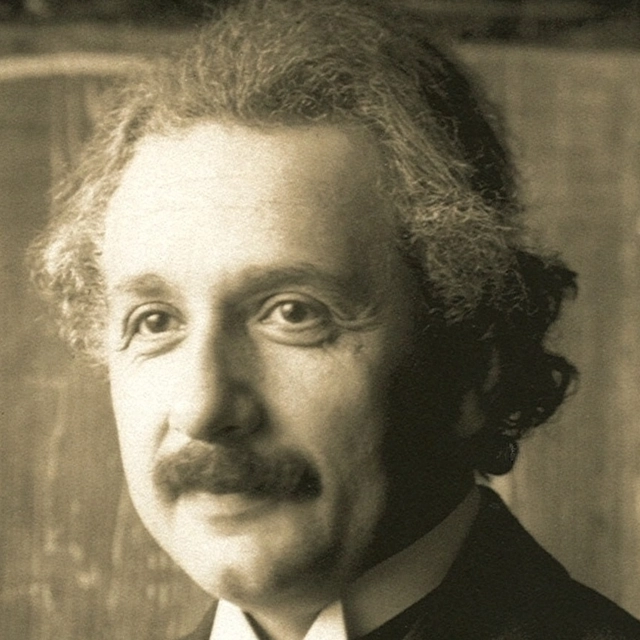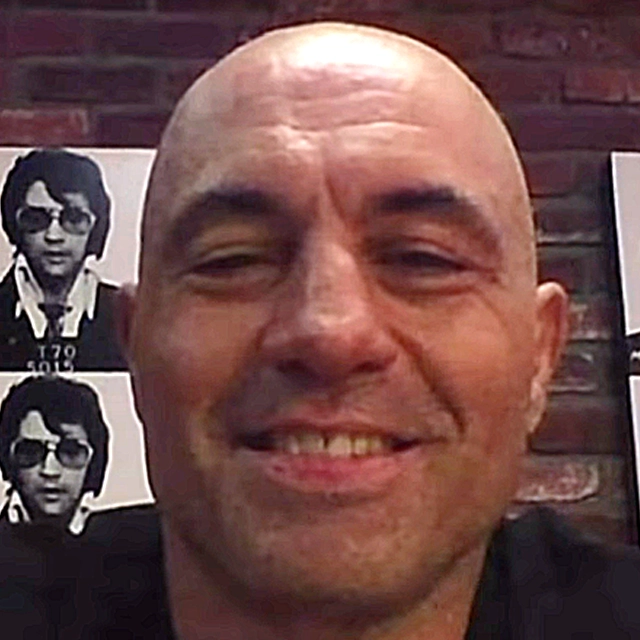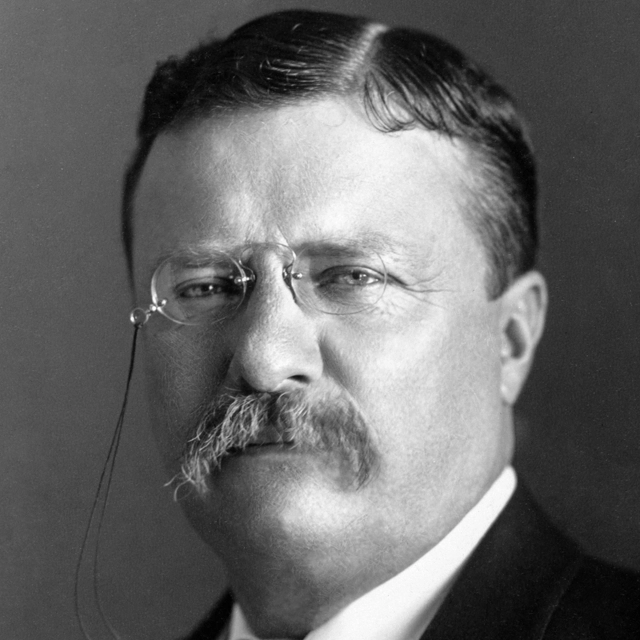Recommended by 2 experts
Good to Great Audiobook Summary
Built To Last, the defining management study of the nineties, showed how great companies triumph over time and how long-term sustained performance can be engineered into the DNA of an enterprise from the very beginning.
But what about companies that are not born with great DNA? How can good companies, mediocre companies, even bad companies achieve enduring greatness? Are there those that convert long-term mediocrity or worse into long-term superiority? If so, what are the distinguishing characteristics that cause a company to go from good to great?
Over five years, Jim Collins and his research team have analyzed the histories of 28 companies, discovering why some companies make the leap and others don’t. The findings include:
- Level 5 Leadership: A surprising style, required for greatness.
- The Hedgehog Concept: Finding your three circles, to transcend the curse of competence.
- A Culture of Discipline: The alchemy of great results.
- Technology Accelerators: How good-to-great companies think differently about technology.
- The Flywheel and the Doom Loop: Why those who do frequent restructuring fail to make the leap.
Other Top Audiobooks
Good to Great Audiobook Narrator
Jim Collins is the narrator of Good to Great audiobook that was written by Jim Collins
Jim Collins is a student and teacher of what makes great companies tick, and a Socratic advisor to leaders in the business and social sectors. Having invested more than a quarter-century in rigorous research, he has authored or coauthored six books that have sold in total more than 10 million copies worldwide. They include Good to Great, Built to Last, How the Mighty Fall, and Great by Choice.
Driven by a relentless curiosity, Jim began his research and teaching career on the faculty at the Stanford Graduate School of Business, where he received the Distinguished Teaching Award in 1992. In 1995, he founded a management laboratory in Boulder, Colorado.
In addition to his work in the business sector, Jim has a passion for learning and teaching in the social sectors, including education, healthcare, government, faith-based organizations, social ventures, and cause-driven nonprofits.
In 2012 and 2013, he had the honor to serve a two-year appointment as the Class of 1951 Chair for the Study of Leadership at the United States Military Academy at West Point. In 2017, Forbes selected Jim as one of the 100 Greatest Living Business Minds.
Jim has been an avid rock climber for more than forty years and has completed single-day ascents of El Capitan and Half Dome in Yosemite Valley.
Learn more about Jim and his concepts at his website, where you’ll find articles, videos, and useful tools. jimcollins.com
About the Author(s) of Good to Great
Jim Collins is the author of Good to Great
More From the Same
- Publisher : HarperAudio
- Abraham
- American Gods [TV Tie-In]
- Dead Ringer
- House of Sand and Fog
- Prey
Good to Great Full Details
| Narrator | Jim Collins |
| Length | 9 hours 58 minutes |
| Author | Jim Collins |
| Category | |
| Publisher | HarperAudio |
| Release date | July 13, 2010 |
| ISBN | 9780062045874 |
Subjects
The publisher of the Good to Great is HarperAudio. includes the following subjects: The BISAC Subject Code is Business & Economics, Business Development, Development
Additional info
The publisher of the Good to Great is HarperAudio. The imprint is HarperAudio. It is supplied by HarperAudio. The ISBN-13 is 9780062045874.
Global Availability
This book is only available in the United States.
Good to Great is recommended by
Dave Ramsey
David Lawrence Ramsey III is a personal finance personality, radio show host, author,& businessman.
Recommends this book
Goodreads Reviews
Riku
September 26, 2017
First and foremost, Good to Great has no breakthrough concepts to offer. Collins is good at inventive metaphors and catch phrases to push concepts through but ultimately there is really nothing counter-intuitive or revolutionary about the results of this study.That said, the concepts in the book might still be valuable for managers, CEOs and other professionals. Here is a brief summary of the book and a short tour on how to take your company from Good to Great:Think of this as a time-line to be followed:First step is: To have A 'Level 5 Leader'- A self-effacing leader. A humble leader with a strong drive and indefatigable will for perfection. Someone who puts the company over personal success and never clamors for the limelight.Second Step is: To First decide the Who question and then the What Question.- So have a Level 5 Leader.- Who then picks a great management team - Collins uses the metaphor of finding the right people for the bus and the right seats for them before deciding where the bus is going to be heading towards.Third Step is: To understand all the basic facts about the situation and the company- So we have the ideal top management in place.- Who in turn now brainstorms to figure out a goal/direction for the company after taking into account all the data available, whether good or bad.Fourth Step is: To implement the 'Hedgehog Concept'- So they confront all the realities and decide on a direction- Which is based on the ability of the company, the passion of the people in it and money making ability of the goal. - This is called using 'The Hedgehog Concept' and the 'Three Circles Concept'. You have to choose the very intersection of these three circles as your driving direction. You might have a lot of interests/passions, your company might have a lot of money-making options and you might have a lot of competencies - BUT, the point of intersection of all three should be your ONLY core focus.[It is called Hedgehog Concept by contrasting hedgehogs to foxes - foxes are wily and know a lot of things, hedgehogs are wise and one thing well. It is the equivalent to the old proverb of 'jack-of-all-trades and master-of-none']THE HEDGEHOG CONCEPT[image error]Fifth Step is: To have Complete Faith and Honesty - Called the 'The Stockdale Paradox'- Once you identify your defining goal using the Hedgehog Concept,- Have complete and unwavering belief and faith in this audaciously ambitious goal (to be the best in the world in the direction/field chosen.- At the same time maintain complete transparency and exposure to the brutal facts about the environment.- Believe you will prevail, no matter what. Keeping faith in the goal even in the face of the direst contrary facts.Sixth Step is: To instill a Culture of DIscipline in the organization- Keep working very very hard with complete determination and without bravado towards overcoming those contrary facts and obstacles towards the singe goal/direction arrived at earlier.Seventh Step and the Overarching Concept is: To Keep turning 'The Flywheel'- Use the Culture of Discipline and Build Momentum with these little steps and successes and then take all caution to not upset the momentum by misguided side steps. - This is the Fly wheel concept.Thus with Great Leadership, Great Understanding of Strengths & Weaknesses, Great Confidence, Great Focus, Great Determination and Great Discipline, consistently applied over 15-30 years makes for a great company.The whole story can be summarized in this phrase: "Build up - Breakthrough - Flywheel!"THE FLYWHEEL CONCEPT[image error]This diagram also gives a visual summary of the entire book and can be used as a ready reference.ConclusionSo, in conclusion, 'Good to Great' by Jim Collins has nothing new to offer but still provides us with a concrete 5-year study and a plausible reason to follow such common sensical things such as finding the right people, understanding what we can best at, believing in ourselves and working hard until success eventually turns up. It is an optimistic and feel-good result that just might be simple enough to be true.
Ahmad
January 04, 2022
Good to Great: Why Some Companies Make the Leap... and Others Don't, James C. CollinsGood to Great: Why Some Companies Make the Leap... and Others Don't is a management book by Jim C. Collins that describes how companies transition from being good companies to great companies, and how most companies fail to make the transition. The book was published on October 16, 2001. Greatness is defined as financial performance several multiples better than the market average over a sustained period. Using tough benchmarks, Collins and his research team identified a set of elite companies that made the leap to great results and sustained those results for at least fifteen years. How great? After the leap, the good-to-great companies generated cumulative stock returns that beat the general stock market by an average of seven times in fifteen years, better than twice the results delivered by a composite index of the world's greatest companies, including Coca-Cola, Intel, General Electric, and Merck. Collins finds the main reason certain companies become great is they narrowly focus the company’s resources on their field of key competence.عنوانهای چاپ شده رد ایران: «از خوب به عالی»؛ «از عرش به فرش»؛ «انتخاب برتری»؛ «انتخاب عالی»، مترجم: عهدیه عبادی؛ «با انتخاب خود بزرگ شوید»؛ «با انتخاب خود مهم شوید» مترجم: متین عربلو؛ «بهتر از خوب»، مترجم: فضل الله امینی؛ «تعالی مبنی بر انتخاب صحیح»، مترجمها حسن زارعی ثمین، بهزاد محمدیان، مهدی شعله؛ نویسنده: جیم کالینز؛ تاریخ نخستین خوانش: روز بیستم ماه فوریه سال2006میلادیعنوان: از خوب به عالی: چرا برخی از شرکتها جهش میکنند...؛ و سایرین نمیکنند؛ نویسنده: جیم کالینز؛ مترجم ناهید سپهرپور؛ تهران، پیک آوین، سال1383؛ در301ص؛ جدول، عکس، نمودار، شابک9648148031؛ چاپهای چهارم و پنجم سال1384؛ چاپهای هفتم و هشتم سال1386؛ چاپهای نهم و دهم سال1387؛ چاپ یازدهم سال1388؛ شابک9789648148039؛ چاپ دیگر تهران، آوین، سال1386؛ چاپ سیزدهم سال1389؛ چاپ هیجدهم سال1392؛ موضوع راهبری، برنامه ریزی راهبردی، تحول در سازمان، مدیریت، نوآوری - سده21معنوان: از خوب به عالی: چرا برخی شرکتها پیشرفت میکنند و برخی دیگر از پیشرفت باز میمانند؛ نویسنده: جیم کالینز؛ مترجم لیلا رضیئی؛ تهران، آرایان، سال1395؛ در336ص؛ شابک9786007133750؛عنوان: از خوب به عالی: چرا برخی شرکتها جهش میکنند و بعضیهای دیگر نه؛ نویسنده: جیم کالینز؛ مترجم: صدیقه اشتری؛ تهران، هورمزد، سال1395؛ در350ص؛ شابک9786006959781؛عنوان: از عرش به فرش: چگونه شرکتهای قدرتمند سقوط میکنند؟ و چرا برخی از شرکتها هرگز تسلیم نمیشوند؟؛ نویسنده: جیم کالینز؛ مترجم لیلا سالاری؛ تهران، هورمزد، سال1395؛ در270ص؛ شابک9786006958927؛عنوان: انتخاب برتری، مترجم: عبدالرضا رضایی نژاد، تهران، فرا، سال1394، در202ص؛و ...؛خوب دشمن عالی است؛ این مهمترین مفهومی است، که «جیم کالینز» نویسنده ی این کتاب کوشش دارد، خوانشگر را متوجه آن کند؛ آقای «کالینز» به همراه تیم پژوهشی خود، حرکت مجموعه ای از شرکتها را، در طول سی سال، بررسی کرده اند، و به نتایجی رسیده اند، که نشان میدهد «چرا تعدادی از شرکتها از مرحله ی خوب رد میشوند، و به سطح عالی میرسند»؛ ما شرکتهایی رو میشناسیم، که خوب هستند؛ شرکتهایی در دوره ای، رشد فزاینده ای دارند، و دوباره افول میکنند؛ اما شرکتهای عالی، که اتفاقا ممکن است نامشان، به اندازه شرکتهای خوب، شناخته شده نباشد، هماره رشدی صعودی را تجربه میکنند، و ارزش سهام آنها، چندین برابر نرخ سهام بازار است؛ ...؛تاریخ بهنگام رسانی 05/12/1399هجری خورشیدی؛ 14/10/1400هجری خورشیدی؛ ا. شربیانی
R.K.
November 30, 2020
Why Indie Authors Should Read Business BooksI am finally pursuing my lifelong passion of becoming an author, and writing is a business, so I needed to invest in myself. I figured "the bible" of the business world would have some interesting things to say. After all, a business of one is still a business and who wouldn't enjoy the leap from mediocrity to longevity? The book made it clear that building a great business isn't just about a great leader who exits the company, only to have it fall apart. What makes a great business, and leader of the business, is someone who is able to build something that will last long after their lifetime. That should resonate with authors. I don't know any authors that want their books to disappear without their presence? We have the benefit of creating products that at the very least will never go out of style. Innovations may change the way we read but they will never eliminate books altogether. What we write will last and it's our responsibility to build something from it so people actually give a damn about our work long after we are gone. The lessons in this book teach a person how to develop a strategy, how to build a team, the importance of being disciplined, and the importance of managing expectations.The Hedgehog Concept is something creatives should be able to maneuver to their advantage. It's all about finding what you can be best at, passionate about, and quantifying how to measure your success. For an author maybe that's finding a niche and having the discipline to stick with it rather than chasing the latest genre fad. For building a team, again think about how many people it takes to make a book. You don't just write a draft and publish it on KDP. If you do, and are successful than I am jealous but most of us can't write perfection the first go around. You need beta readers to give you general feedback on what's working and what's not; you need an editor (or two) to make sure it's readable; you need a top-notch book cover (some authors can make their own, some need to add a graphic designer to their team) and finally you need to build your audience, because they're the most important part of the team. Though there are a lot of lessons in this book the final thing I'm gonna touch on is the Stockdale Paradox. It's all about managing expectations. You can truly believe you are going to find success, while also managing that expectation. Stockdale was a POW in Vietnam who knew he would return home but kept his sanity because he knew it would be a while, while other soldiers in the camp were overly optimistic, thought they would get home by Christmas, only to be heartbroken when their expectations failed. Pursuing a creative endeavor is still a business, and today it's never been easier for someone to enter that business It's my educated guess that it's in order for creatives to educate themselves on traditional business practices if they hope to sustain long-term growth and success in their field.
Praveen
December 11, 2019
"People often ask, "what motivates you to undertake these huge research projects?"It's a good question. The answer is "curiosity."There is nothing I find more exciting than picking a question that I don't know the answer to and embarking on a quest for answers. It's deeply satisfying to climb into the boat, like Lewis and Clark, and head west, saying," We don't know what we will find when we get there, but we'll be sure to let you know when we get back."This undaunted curiosity is the stimulus of this work, proclaims the author, in the beginning, justifying why he got down to such a grueling task. Though this book is exclusively for the management students and for the corporate guys, I still feel, this book is very well researched and can be read by them also, who have the least interests in companies and businesses. This book is a result of the hard toil of a large research team of Jim Collins after 'Built to Last'.If you read it, you will find the reason why millions of copies have been sold of this. Wall Street Journal's CEO council declared it the best management book they have read.This book is all about why some companies leap from 'good to great' and others don't!The first thing it tries to preach is that Good is the enemy of great.Few people attain greatness, in large part because it is just so easy to settle for a good life. Next, the book talks about a kind of 'Level 5 leadership', "leaders of a paradoxical mix of personal humility and professional will.they are fanatically driven, infected with an incurable need to produce sustainable results. they display workmanlike diligence, more plow horse than show horse. they look out of a window to attribute success to factors other than themselves."In the subsequent chapters, comes the idea of choosing the right guys. It's important first getting the right people on the bus (and wrong people off the bus) and then figure out where to drive it.Then there is a 'Stockdale Paradox' in this book, which is equally applicable in any field of life. "Retain faith that you will prevail in the end, regardless of the difficulties.....And at the same time ......Confront the most brutal facts of your current reality, whatever they might be."There are many other concepts outlined in this book, they look technical, so much business involved in them, but they are quite handy even to the simpler minds, quite comprehensible even to those ordinary mortals like me. The research done for this book may have taken a huge amount of resources, time and energy, but as a consequence, the major findings and learnings of this project are rather uncomplicated. The key elements of greatness are deceptively simple and straightforward. I feel this book is a wonderful exhibition of undemanding intelligence encrusted with due diligence. In the end, Even if you think in contrast. If you think you are already gratified to the goodness around you and think after reading the title of this book.....Why greatness? I don't need that! Then the book has an answer for you as well. It says it's almost a nonsense question. If you are engaged in a work that you love and care about, for whatever reason, then the question needs no answer. The question is not why, but how!
Shane
July 13, 2020
I love this short lesson from Jim Collin's Good to Great:"Put your best people on your biggest opportunities, not your biggest problems."
Q.T.
May 28, 2018
Well I read Good to Great and ya know what? I liked it. It had a lot to say on how to build a business from scratch and turn it into a thriving success. It was an easily digestible piece full of useful tidbits I hope to apply to my every day life as an author. I need to surround myself with the right team, focus on my goal, remain disciplined/not chase fads, and manage my expectations. Sounds easy enough right?
Morgan
October 25, 2020
Oh my god!This book makes me FREAK OUT!!!It’s so DAMN GOOD.No!FUCK THAT!!!It’s FUCKIN GREAT 😬There you go folks...From DAMN GOOD to FUCKIN GREAT.But seriously...There are some really useful ideas in this book.Like:Three Circles:1. What are you passionate about?2. What can you be best in the world at?3. What is your hedgehog concept?It sounds dumb when it’s bulleted like this.But it’s not. You just have to read it.K?Just read it. Another key concept is:The flywheel.Yass qween yass.Push that FUCKIN FLYWHEEL bitch!Again.Read it.Another:The window and the mirror.When you want to know how shit got fucked up.Look in the mirror dude!When you want to know how shit got so rad.Look out the window. Look at all that white privilege (if you have some).And if you didn’t read it.Than look in the mirror at the person who fucked up.It’s you. That’s level 5!!!! (also in the book)Now go do. P.S. G2G is old.It’s pimps companies like:Circuit City and Hewlett Packard. Who?Wait what?Not exactly cutting edge?That’s true. Don’t trip. They used to fucking DOMINATE. And the principles they used remain fresh AF.And there in the book. So.....Fuckin YES 🙌 Get and read this great book. ⭐️⭐️⭐️⭐️⭐️ (x5 stars)
Isaac
August 25, 2018
Just being good is not enough! Pursue greatness!!Jim Collins, an expert in the field of leadership, introduced a story from Aesop’s Fables called “The Fox and the Hedgehog” in his own book “Good to Great.” A fox is a cunning and beautiful creature. It is also fast, lean, and a proficient hunter. In contrast, a hedgehog is small, slow, and plump. Therefore, a hedgehog only concerns itself with finding food and caretaking its home. Every day, a fox thinks of strategies to hunt the hedgehog and bides its most opportune chance. However, when the fox attacks the hedgehog, the hedgehog will curl itself into a ball to protect itself. The fox ultimately fails and returns home to think of a new plan. Yet, the same result repeats itself every time. The fox ends up with nothing, and the hedgehog stands victorious.The fox has much knowledge, but the hedgehog knows one critical piece of information. Great organizations are like the hedgehog. Like the hedgehog, great organizations think of easy, effective,impactful action plans in the simplest methods. According to Collins, the hedgehog’s strategy concept of focusing on a single plan is born from understanding one’s own identity with accuracy and depth.
Sebastian
March 24, 2018
Simple, yet very striking message that has resonated with me perfectly.Author (& the well-organised, scientific approach to back up his thesis) confirms what my experience tells me - that transformation of good to great is enabled by simple truths we keep neglecting on the daily basis because we need some stuff "right here & right now", e.g.:* building up team in a steady way, with PROPER people, not just available people* strategic goals are important for everyone, you just sometimes need to state them in a different way for different people - but having unique specialty/target/focus(/thing your company excels in) aka hedgehog concept is crucial to distinguish from mediocrity* iterative, tiny (but consistent) steps - not the quasi-random "leapfrogging" - is what builds up success long-term* culture of discipline - I couldn't emphasise it too much - some sort of discipline & duty HAS to be within people, not in policies or control mechanisms (which lead only to US vs THEM syndrome)* high standards (by example) from the top to the ground17 years have passed since this book has go published, but it didn't get outdated at all - highly recommended classic.
Sergey
October 27, 2019
I wish more authors of business best sellers would employ such rigorous research to substantiate their writing as Jim Collins did in Good to Great. The more rigorous research however, the less surprising the findings. What did distinguish companies at the stage of transition from good to great was:*
Kathleen
February 21, 2009
I read this in a leadership class and it was very appropriate. I will never be the CEO of a major company, but I will help run a household, participate in a church family, help lead a therapy team, and will have many more opportunities to lead. This book gave a lot of insight into why companies are able to climb in growth and industry, but that same insight can be applied in most of life circumstances where people are grouped together. I recommended this book to multiple people working in large companies, but also to my pastor at the time. It's relevant!
Len
April 15, 2012
I finally got around to reading Good to Great. It more or less lived up to the hype as being both inspirational and instructional. I just have three quick comments:1. Like many business books, this would be better as a long magazine article instead of a book. The author, while deft, belabors point after point. While it was less true here than in some other business books, it's still longer than it needs to be. 2. A few of the ideas put forth -- e.g., the hedgehog concept, the three circles -- are brilliant observations, but, to my way of thinking, still require a certain kind of magic or special sauce that cannot be found by adhering to a set of principles. It's just too easy to identify and believe in the wrong Hedgehog concept and not know it until it's too late. I guess what I'm saying is that while the ideas are great, they can only go so far in helping put your business on the right track. Ingenuity, creativity, and a certain amount of luck will be needed too. 3. Don't read this on an iPhone. The charts and graphs are too small, and the software (in this case Nook, but I think all of the apps) didn't allow for enlarging the images. But all in all, I'd still give this a very strong recommendation for anyone in a leadership role, or anyone who aspires to be in a leadership role
Tanja
October 12, 2014
This book was collecting dust on my shelf for at least a year before I finally got around to it. I thought it would be a hopelessly overwhelming book to read. I could not have been more wrong. This is a very clear, concise and easily understood book. The author and his team spent years understanding why some companies beat the market and others did not. This was done after first having carefully made a selection and the conducted indepth interviews. Then they drew the conclusions into lucid and enlightening chapters. Definitely recommended!
Most Popular Audiobooks
Frequently asked questions
Listening to audiobooks not only easy, it is also very convenient. You can listen to audiobooks on almost every device. From your laptop to your smart phone or even a smart speaker like Apple HomePod or even Alexa. Here’s how you can get started listening to audiobooks.
- 1. Download your favorite audiobook app such as Speechify.
- 2. Sign up for an account.
- 3. Browse the library for the best audiobooks and select the first one for free
- 4. Download the audiobook file to your device
- 5. Open the Speechify audiobook app and select the audiobook you want to listen to.
- 6. Adjust the playback speed and other settings to your preference.
- 7. Press play and enjoy!
While you can listen to the bestsellers on almost any device, and preferences may vary, generally smart phones are offer the most convenience factor. You could be working out, grocery shopping, or even watching your dog in the dog park on a Saturday morning.
However, most audiobook apps work across multiple devices so you can pick up that riveting new Stephen King book you started at the dog park, back on your laptop when you get back home.
Speechify is one of the best apps for audiobooks. The pricing structure is the most competitive in the market and the app is easy to use. It features the best sellers and award winning authors. Listen to your favorite books or discover new ones and listen to real voice actors read to you. Getting started is easy, the first book is free.
Research showcasing the brain health benefits of reading on a regular basis is wide-ranging and undeniable. However, research comparing the benefits of reading vs listening is much more sparse. According to professor of psychology and author Dr. Kristen Willeumier, though, there is good reason to believe that the reading experience provided by audiobooks offers many of the same brain benefits as reading a physical book.
Audiobooks are recordings of books that are read aloud by a professional voice actor. The recordings are typically available for purchase and download in digital formats such as MP3, WMA, or AAC. They can also be streamed from online services like Speechify, Audible, AppleBooks, or Spotify.
You simply download the app onto your smart phone, create your account, and in Speechify, you can choose your first book, from our vast library of best-sellers and classics, to read for free.
Audiobooks, like real books can add up over time. Here’s where you can listen to audiobooks for free. Speechify let’s you read your first best seller for free. Apart from that, we have a vast selection of free audiobooks that you can enjoy. Get the same rich experience no matter if the book was free or not.
It depends. Yes, there are free audiobooks and paid audiobooks. Speechify offers a blend of both!
It varies. The easiest way depends on a few things. The app and service you use, which device, and platform. Speechify is the easiest way to listen to audiobooks. Downloading the app is quick. It is not a large app and does not eat up space on your iPhone or Android device.
Listening to audiobooks on your smart phone, with Speechify, is the easiest way to listen to audiobooks.

